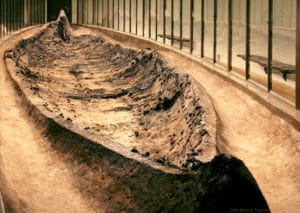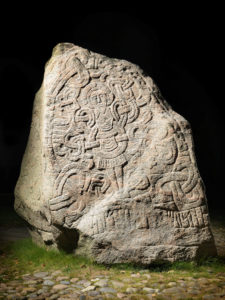A short note about the Dani in “Getica” by the historian Jordanes is believed to be an early mention of the Danes, one of the ethnic groups from whom modern Danes are descended. The Danevirke defense structures were built in phases from the 3rd century forward and the sheer size of the construction efforts in AD 737 are attributed to the emergence of a Danish king. A new runic alphabet was first used around the same time and Ribe, the oldest town of Denmark, was founded about AD 700.
Viking and Middle Ages:
From the 8th to the 10th century the wider Scandinavian region was the source of Vikings. They colonized, raided, and traded in all parts of Europe. The Danish Vikings were most active in the eastern and southern British Isles and Western Europe. They conquered and settled parts of England (known as the Danelaw) under King Sweyn Forkbeard in 1013, and France where Danes and Norwegians founded Normandy with Rollo as head of state. More Anglo-Saxon pence of this period have been found in Denmark than in England.

Denmark was largely consolidated by the late 8th century and its rulers are consistently referred to in Frankish sources as kings (reges). Under the reign of Gudfred in 804 the Danish kingdom may have included all the lands of Jutland, Scania and the Danish islands, excluding Bornholm. The extant Danish monarchy traces its roots back to Gorm the Old, who established his reign in the early 10th century. As attested by the Jelling stones, the Danes were Christianised around 965 by Harald Bluetooth, the son of Gorm. It is believed that Denmark became Christian for political reasons so as not to get invaded by the rising Christian power in Europe, the Holy Roman Empire, which was an important trading area for the Danes. In that case, Harald built six fortresses around Denmark called Trelleborg and built a further Danevirke. In the early 11th century, Canute the Great won and united Denmark, England, and Norway for almost 30 years with a Scandinavian army.

Throughout the High and Late Middle Ages, Denmark also included Skåneland (the areas of Scania, Halland, and Blekinge in present-day south Sweden) and Danish kings ruled Danish Estonia, as well as the duchies of Schleswig and Holstein. Most of the latter two now form the state of Schleswig-Holstein in northern Germany.
In 1397, Denmark entered into a personal union with Norway and Sweden, united under Queen Margaret I. The three countries were to be treated as equals in the union. However, even from the start, Margaret may not have been so idealistic—treating Denmark as the clear “senior” partner of the union. Thus, much of the next 125 years of Scandinavian history revolves around this union, with Sweden breaking off and being re-conquered repeatedly. The issue was for practical purposes resolved on 17 June 1523, as Swedish King Gustav Vasa conquered the city of Stockholm. The Protestant Reformation spread to Scandinavia in the 1530s, and following the Count’s Feud civil war, Denmark converted to Lutheranism in 1536. Later that year, Denmark entered into a union with Norway.
Early Modern History:
After Sweden permanently broke away from the personal union, Denmark tried on several occasions to reassert control over its neighbor. King Christian IV attacked Sweden in the 1611–1613 Kalmar War but failed to accomplish his main objective of forcing it to return to the union. The war led to no territorial changes, but Sweden was forced to pay a war indemnity of 1 million silver riksdaler to Denmark, an amount known as the Älvsborg ransom. King Christian used this money to found several towns and fortresses, most notably Glückstadt (founded as a rival to Hamburg) and Christiania. Inspired by the Dutch East India Company, he founded a similar Danish company and planned to claim Ceylon as a colony, but the company only managed to acquire Tranquebar on India’s Coromandel Coast. Denmark’s large colonial aspirations included a few key trading posts in Africa and India. While Denmark’s trading posts in India were of little note, it played an important role in the highly lucrative transatlantic slave trade, through its trading outposts in Fort Cristiansborg in Osu, Ghana though which 1.5 million slaves were traded. While the Danish colonial empire was sustained by trade with other major powers, and plantations – ultimately a lack of resources led to its stagnation.
